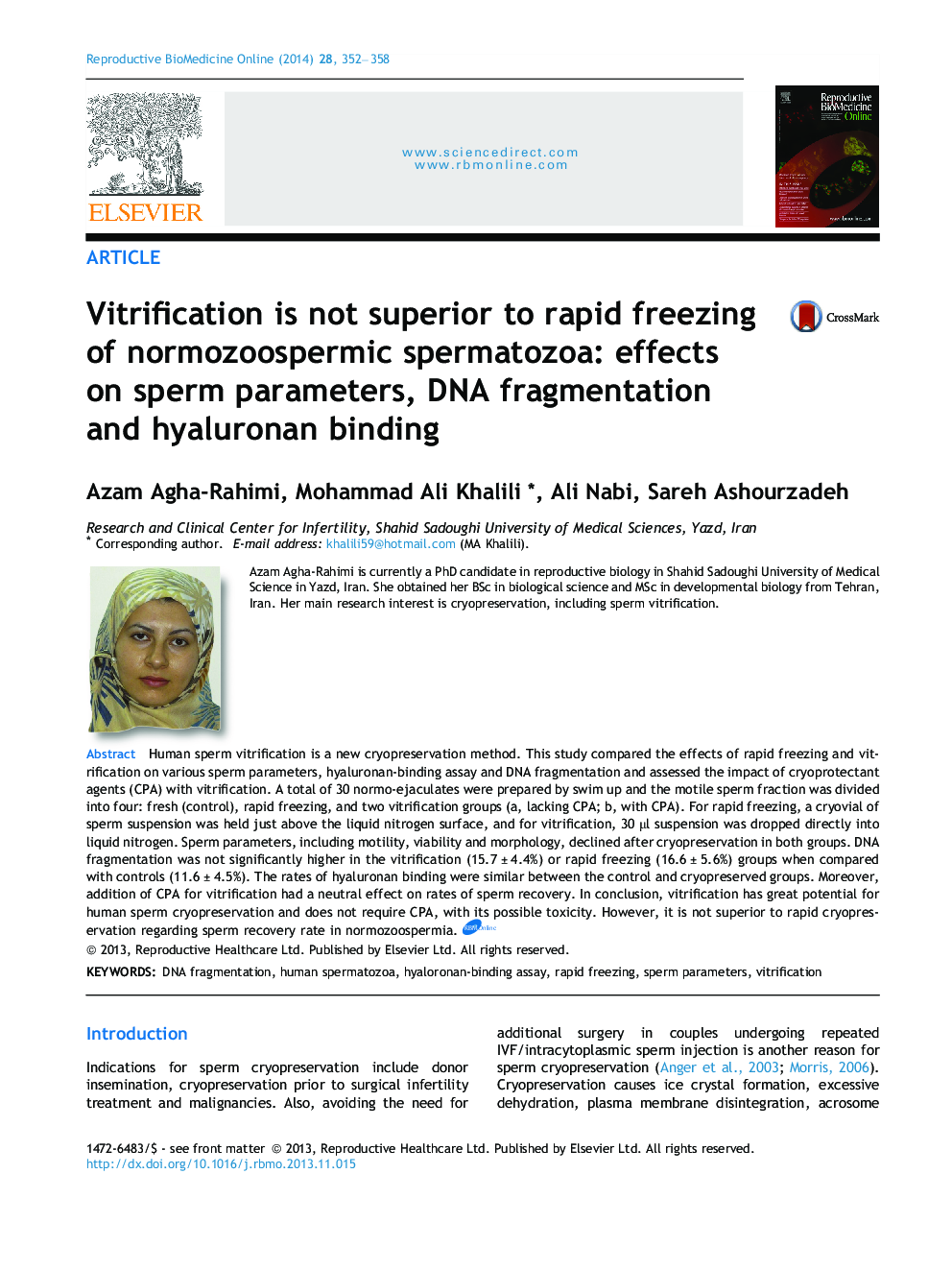| کد مقاله | کد نشریه | سال انتشار | مقاله انگلیسی | نسخه تمام متن |
|---|---|---|---|---|
| 6189074 | 1256711 | 2014 | 7 صفحه PDF | دانلود رایگان |

Human sperm vitrification is a new cryopreservation method. This study compared the effects of rapid freezing and vitrification on various sperm parameters, hyaluronan-binding assay and DNA fragmentation and assessed the impact of cryoprotectant agents (CPA) with vitrification. A total of 30 normo-ejaculates were prepared by swim up and the motile sperm fraction was divided into four: fresh (control), rapid freezing, and two vitrification groups (a, lacking CPA; b, with CPA). For rapid freezing, a cryovial of sperm suspension was held just above the liquid nitrogen surface, and for vitrification, 30 μl suspension was dropped directly into liquid nitrogen. Sperm parameters, including motility, viability and morphology, declined after cryopreservation in both groups. DNA fragmentation was not significantly higher in the vitrification (15.7 ± 4.4%) or rapid freezing (16.6 ± 5.6%) groups when compared with controls (11.6 ± 4.5%). The rates of hyaluronan binding were similar between the control and cryopreserved groups. Moreover, addition of CPA for vitrification had a neutral effect on rates of sperm recovery. In conclusion, vitrification has great potential for human sperm cryopreservation and does not require CPA, with its possible toxicity. However, it is not superior to rapid cryopreservation regarding sperm recovery rate in normozoospermia.Human sperm vitrification is a new cryopreservation method that has been introduced recently. This study compared the effects of rapid freezing with vitrification on rates of sperm parameters, hyaluronan-binding assay and DNA fragmentation after thawing/warming and assessed the impact of cryoprotectant agent (CPA) on vitrification. The study was performed on 30 ejaculates prepared using the swim-up technique. Each motile sperm suspension was divided into four: control (fresh); rapid freezing; and two vitrification groups (a, lacking CPA; b, with CPA). For rapid freezing, a cryovial of sperm suspension was held above the surface of liquid nitrogen. For vitrification, 30 μl sperm suspension was dropped into liquid nitrogen directly. The rates of progressive motility (86.6 ± 5.9%) and viability (95.8 ± 3.9%) in controls declined significantly, to 40.0 ± 13.0% and 63.2 ± 7.7% for rapid freezing and 41.9 ± 10.3% and 64.4 ± 10.0% for vitrification, respectively. Normal sperm morphology was also significantly decreased after cryopreservation in all groups. DNA fragmentation was higher with rapid freezing compared with fresh controls (16.6 ± 5.6% vs. 11.6 ± 4.5%, P = 0.01), but DNA fragmentation did not increase significantly in vitrified samples (15.7 ± 4.4%). The rates of hyaluronan binding were similar between the control and cryopreserved groups. Moreover, addition of CPA for vitrification had a neutral effect on rates of sperm recovery. In conclusion, vitrification has great potential for human sperm cryopreservation and does not require CPA, with its possible toxicity. However, it is not superior to rapid cryopreservation regarding sperm recovery rate in normozoospermia.
Journal: Reproductive BioMedicine Online - Volume 28, Issue 3, March 2014, Pages 352–358